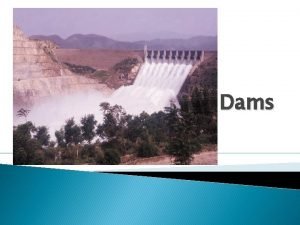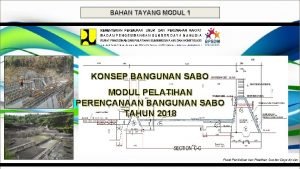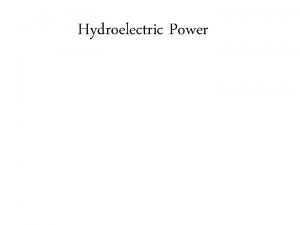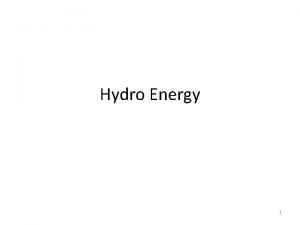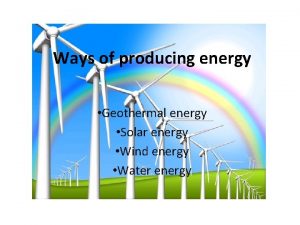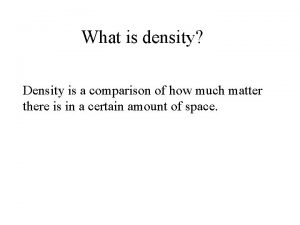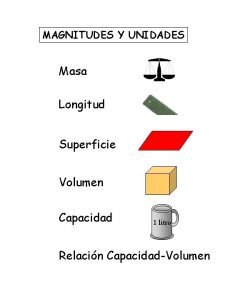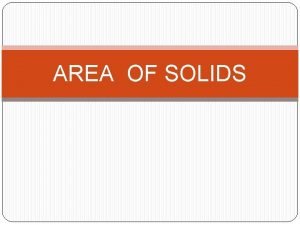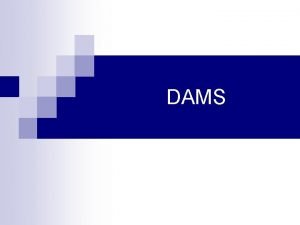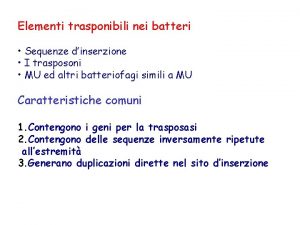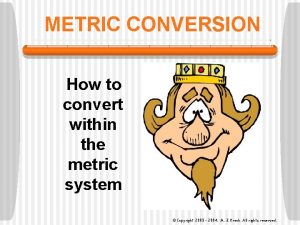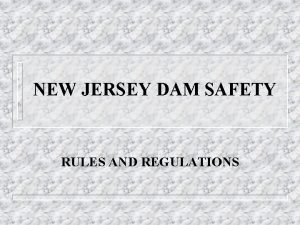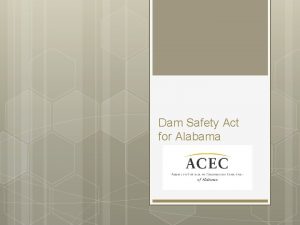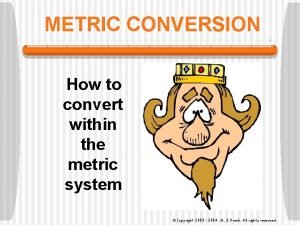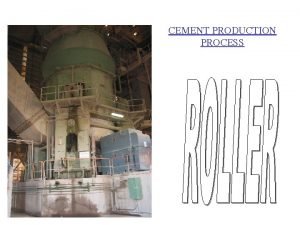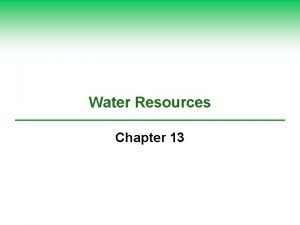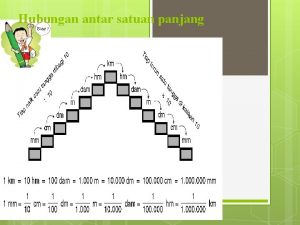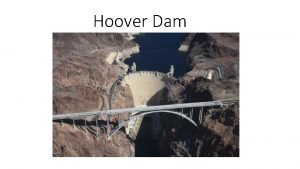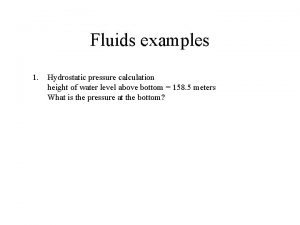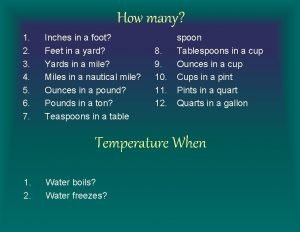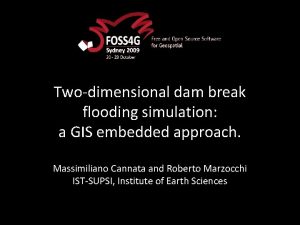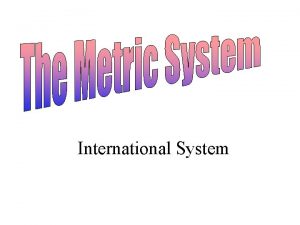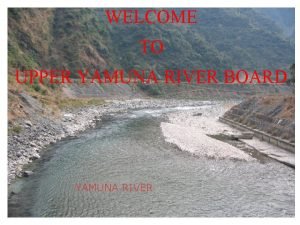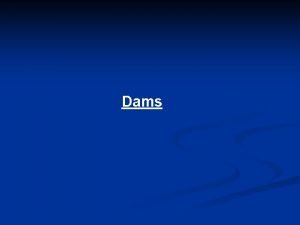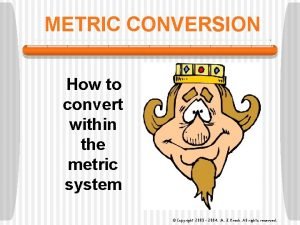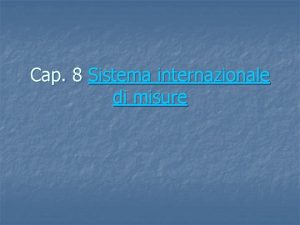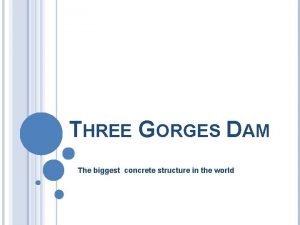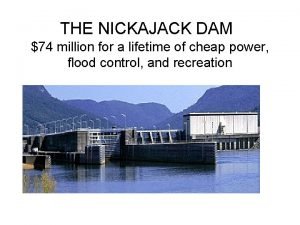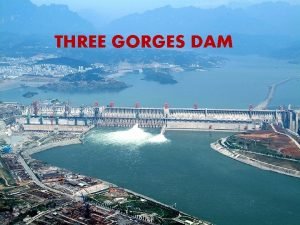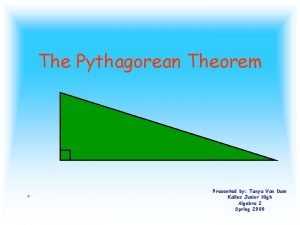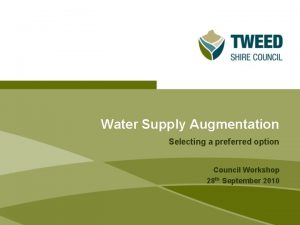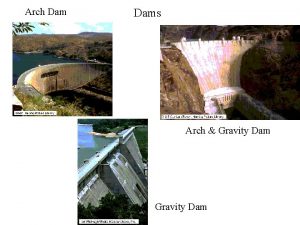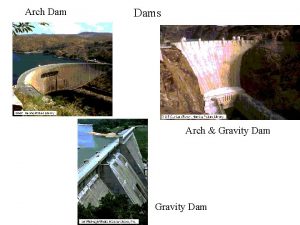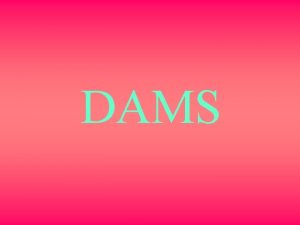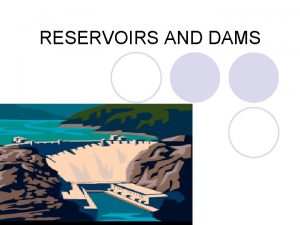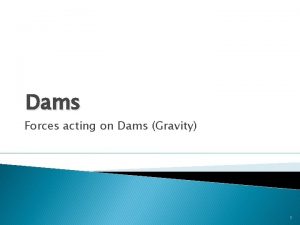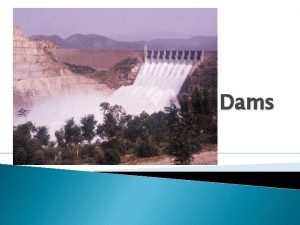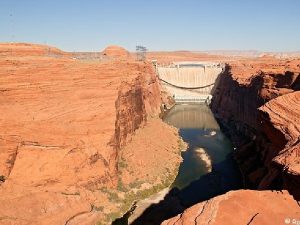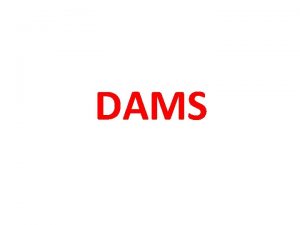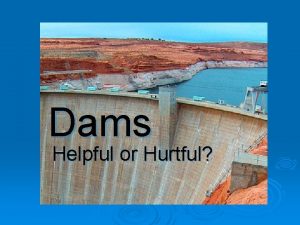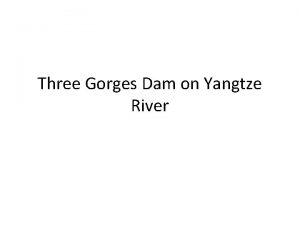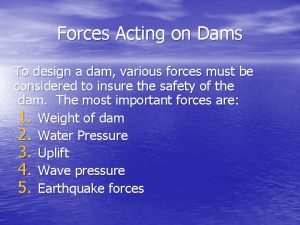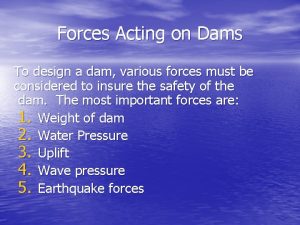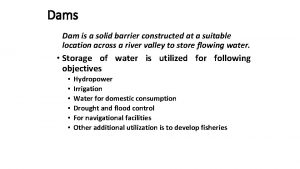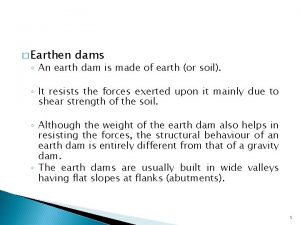Gravity Dam Gravity Dams A Gravity dam has



































































































- Slides: 99

Gravity Dam • Gravity Dams A Gravity dam has been defined as a “structure which is designed in such a way that its own weight resist the external forces”. This type of a structure is most durable and solid and requires very less maintenance. • Such dams are constructed of masonry or Concrete. • However, concrete gravity dams are preferred these days and mostly constructed.

Gravity Dam(Contd. . ) • • • Criteria for selection of dam site: construction material, forces acting on gravity dam, modes of failure, stability analysis, safety criteria, methods of design , stress analysis and stress contours, galleries, instrumentation, joints, keys, water seals, temperature control in concrete dams, foundation treatment.

Gravity Dam(Contd. . ) • The line of the upstream face or the line of the crown of the dam if the upstream face is sloping, is taken as the reference line for layout purpose etc. and is known as the Base line of the dam or the „Axis of The Dam‟ When suitable conditions are available such dams can be constructed up to great heights

Gravity Dam(Contd. . )

Gravity Dam(Contd. . ) • Forces Acting on Gravity Dam The Various external forces acting on Gravity dam may be: • Water Pressure • Uplift Pressure • Pressure due to Earthquake forces • Silt Pressure • Wave Pressure • Ice Pressure • The stabilizing force is the weight of the dam itself

Gravity Dam(Contd. . )

Gravity Dam(Contd. . ) • Water Pressure (p) is the most major external force acting on such a dam. The horizontal water pressure, exerted by the weight of the water stored on the upstream side of the dam can be estimated from rule of hydrostatic pressure distribution. • Which is triangular in Shape • When the upstream face is vertical the intensity is Zero at the water surface and equal to w H at the base; where w is the unit weight of water and H is the depth of water. The resultant force due to this external water • P= ½ w H 2 , acting at H/3 from base.

Gravity Dam(Contd. . )

Gravity Dam(Contd. . ) • When the upstream face is partly vertical and partly inclined, the resulting water force can be resolved into horizontal Component (Ph) and Vertical Component (Pv). The Horizontal Component Ph = ½ γH² act at H/3 from the base, & the vertical component (Pv) is equal to weight of the water stored in column ABCA and acts at the C. G. of the Area. Similarly, if there is tail water on the downstream side, it will have horizontal and vertical components

Gravity Dam(Contd. . )

Gravity Dam(Contd. . ) • Uplift Pressure • Water Seeping through the pores, cracks and fissures of the foundation material, and water seeping through dam body and then to the bottom through the joint between the body of the dam. It is the second major external force and must be accounted for in all calculations. Such an uplift force virtually reduces the downward weight of the body of the dam and hence, acts against the dam stability.

Gravity Dam(Contd. . ) • The amount of Uplift is a matter of research and the present recommendations the uplift pressure intensities at the heel and the toe should be taken equal to their respective hydrostatic pressure and joined by a straight line in between. When drainage galleries are provided to relieve the uplift, the recommended uplift at the face of the gallery is equal to the hydrostatic pressure at toe ( w H’ ) plus a 1/3 rd of the difference of the hydrostatic pressure at the heel and at the toe [ w H’ + 1/3 ( w H - w H’) ]. It is also assumed that the uplift pressure are not affected by the earthquake forces. • The uplift pressure can be controlled by constructing cutoff walls under the upstream face, by constructing drainage channels between the dam and its foundations and by pressure grouting the foundation.

Gravity Dam(Contd. . )

Gravity Dam(Contd. . ) • Earthquake Forces • If the dam is to be designed, is to be located in a region which is susceptible to earthquakes, allowance must be made for stresses generated by the earthquakes. • An earthquake produces waves which are capable of shaking the Earth upon which the dam is resting, in every possible direction

Gravity Dam(Contd. . ) • The effect of an earthquake is therefore, equivalent to impairing an acceleration to the foundation of the dam in the direction in which the wave is traveling at the moment, Earthquake waves may move in any direction and for design purpose, it has to be resolved in vertical and horizontal components. Hence, two accelerations, i. e. . one horizontal acceleration ( h ) and one vertical acceleration ( v ) are induced by an earthquake. The value of these acceleration are generally expressed as percentage of the acceleration due to gravity (g) i. e. . = 0. 1 g or 0. 2 g etc.

Gravity Dam(Contd. . ) • On an average, a value of equal to (0. 1 to 0. 15) g is generally sufficient for high dams in seismic zones. In areas of no earthquakes or very less earthquakes, these forces may be neglected. In extreme seismic regions and in conservative designs, even up to 0. 3 g may sometimes be adopted. However, for areas not subjected to extreme earthquakes, h = 0. 1 g and v = 0. 05 g may be used. In extreme seismic regions and in conservative designs, even a value of 0. 3 g may sometimes be adopted.

Gravity Dam(Contd. . ) • Effect of Vertical Acceleration ( v ) • A Vertical acceleration may either downward or Upward. When it is acting in the upward direction, then the foundation of the dam will be lifted upward and becomes close to the body of the dam, and thus the effective weight of the dam will increase and hence, the stress developed will increase.

Gravity Dam(Contd. . ) • When the vertical acceleration is acting downward, the foundation shall try to move downward away and hence is the worst for the design. • Such Accelerations will, therefore exert an Inertial force given by, • v (i. e. . Force = Mass x Acceleration) where W is the total weight of the dam • The net effective weight of the Dam= W- v

Gravity Dam(Contd. . ) • v = kv g Where kv is the fraction of gravity adopted for vertical acceleration, 0. 1 or 0. 2. Net effective weight of dam = W kv g = W(1 - kv )

Gravity Dam(Contd. . ) • Effect of Horizontal Acceleration ( h ) • Horizontal acceleration may cause the following two forces: • Hydrodynamic Pressure • Horizontal Inertia force • Hydrodynamic Pressures - Horizontal acceleration acting towards the reservoir, causes a momentary increase in the water pressure, as the foundation and dam accelerates towards the reservoir and the water resists the movement owing to its inertia. The extra pressure exerted by this process is known as Hydrodynamic Pressure. • According to Von- Karman, the amount of this hydrodynamic force (Pe) is given by Pe = 0. 555 kh w H² and it act at a height of 4 H/3 above the base

Gravity Dam(Contd. . )

Gravity Dam(Contd. . ) • here kh is the fraction of gravity adopted for horizontal acceleration, such as 0. 1, 0. 2 etc. • Moment of this force above Base is Me= 4 H/3 = Pe = 0. 424 Pe H

Gravity Dam(Contd. . )

Gravity Dam(Contd. . )

Gravity Dam(Contd. . )

Gravity Dam(Contd. . )

Gravity Dam(Contd. . )

Gravity Dam(Contd. . )

Gravity Dam(Contd. . )

Gravity Dam(Contd. . )

Gravity Dam(Contd. . )

Gravity Dam(Contd. . )

Gravity Dam(Contd. . )

Gravity Dam(Contd. . )

Gravity Dam(Contd. . )

Gravity Dam(Contd. . )

Gravity Dam(Contd. . )

Gravity Dam(Contd. . )

Gravity Dam(Contd. . )

Gravity Dam(Contd. . )

Gravity Dam(Contd. . )

Gravity Dam(Contd. . )

Gravity Dam(Contd. . )

Gravity Dam(Contd. . )

Gravity Dam(Contd. . )

Gravity Dam(Contd. . )

Gravity Dam(Contd. . )

Gravity Dam(Contd. . )

Gravity Dam(Contd. . )

Gravity Dam(Contd. . )

Gravity Dam(Contd. . )

Gravity Dam(Contd. . )

Gravity Dam(Contd. . )

Gravity Dam(Contd. . )

Gravity Dam(Contd. . )

Gravity Dam(Contd. . )

Gravity Dam(Contd. . )

Gravity Dam(Contd. . )

Gravity Dam(Contd. . )

Gravity Dam(Contd. . )

Gravity Dam(Contd. . )

Gravity Dam(Contd. . )

Gravity Dam(Contd. . )

Gravity Dam(Contd. . )

Gravity Dam(Contd. . )

Gravity Dam(Contd. . )

Gravity Dam(Contd. . )

Gravity Dam(Contd. . )

Gravity Dam(Contd. . )

Gravity Dam(Contd. . )

Gravity Dam(Contd. . )

Gravity Dam(Contd. . )

Gravity Dam(Contd. . )

Gravity Dam(Contd. . )

Gravity Dam(Contd. . )

Gravity Dam(Contd. . )

Gravity Dam(Contd. . )

Gravity Dam(Contd. . )

Gravity Dam(Contd. . )

Gravity Dam(Contd. . )

Gravity Dam(Contd. . )

Gravity Dam(Contd. . )

Gravity Dam(Contd. . )

Gravity Dam(Contd. . )

Gravity Dam(Contd. . )

Gravity Dam(Contd. . )

Gravity Dam(Contd. . )

Gravity Dam(Contd. . )

Gravity Dam(Contd. . )

Gravity Dam(Contd. . )

Gravity Dam(Contd. . )

Gravity Dam(Contd. . )

Gravity Dam(Contd. . )

Gravity Dam(Contd. . )

Gravity Dam(Contd. . )

Gravity Dam(Contd. . )

Gravity Dam(Contd. . )

Gravity Dam(Contd. . )

Gravity Dam(Contd. . )
 Hydraulic lifting dam
Hydraulic lifting dam Perbedaan sabo dam dan check dam
Perbedaan sabo dam dan check dam Nick dams
Nick dams How do dams generate electricity brainpop
How do dams generate electricity brainpop Uses of dams
Uses of dams Advantages and disadvantages of dams
Advantages and disadvantages of dams Dams roma tre
Dams roma tre Tn dams
Tn dams Uplift force on dam
Uplift force on dam Caravaggio specchio
Caravaggio specchio Tasmanian dam case
Tasmanian dam case Forces acting on earthen dam
Forces acting on earthen dam Vertical gates in dams
Vertical gates in dams Types of valleys
Types of valleys Head race and tail race
Head race and tail race A masonry dam of trapezoidal cross section
A masonry dam of trapezoidal cross section Gravity for dummies and dummies for gravity equations
Gravity for dummies and dummies for gravity equations Frank has an eraser
Frank has an eraser Every picture has a story and every story has a moment
Every picture has a story and every story has a moment Problem has been detected and windows
Problem has been detected and windows He who has ears, let him hear he who has eyes let him see
He who has ears, let him hear he who has eyes let him see A problem has
A problem has Spring has sprung poems
Spring has sprung poems Chapter 36 moisture control short answers
Chapter 36 moisture control short answers Wanawish dam
Wanawish dam 8272012
8272012 Mogens dam
Mogens dam Andy van dam
Andy van dam Cuales son las medidas de longitud usadas en venezuela
Cuales son las medidas de longitud usadas en venezuela Aliteresyon
Aliteresyon Už vím dám dopis na zrcadlo či do košíčku na šití
Už vím dám dopis na zrcadlo či do košíčku na šití Tradcie
Tradcie Multiplos y submultiplos del kilometro
Multiplos y submultiplos del kilometro Pr dam hieu brest
Pr dam hieu brest Itukisya dam
Itukisya dam Km dam hm m cm mm
Km dam hm m cm mm Nurek dam
Nurek dam Outcasts in things fall apart
Outcasts in things fall apart Km hm dam
Km hm dam Flax dam definition
Flax dam definition Dam terminology
Dam terminology Ty prid a vladni nam akordy
Ty prid a vladni nam akordy Trasposoni compositi
Trasposoni compositi King henry died unusually drinking chocolate
King henry died unusually drinking chocolate Nj dam safety
Nj dam safety Baldwin hills disaster
Baldwin hills disaster Khdudcm examples
Khdudcm examples Fovea palatine
Fovea palatine Postdam sahası
Postdam sahası Postdam alanı nedir
Postdam alanı nedir Core
Core Laget esk dam j
Laget esk dam j Lauren van dam
Lauren van dam Dam ring in vrm
Dam ring in vrm Drie kloven dam
Drie kloven dam Morphological watershed
Morphological watershed Escala como calcular
Escala como calcular Hoover dam case study
Hoover dam case study Hubungan satuan panjang
Hubungan satuan panjang Hoover dam
Hoover dam Hoover dam
Hoover dam Km-hm-dam-m-dm-cm-mm liter
Km-hm-dam-m-dm-cm-mm liter Enloe dam
Enloe dam Uzunluk ölçüsü merdiveni
Uzunluk ölçüsü merdiveni Dental dam
Dental dam Hoover dam break simulation
Hoover dam break simulation Veikiamasis dalyvis pvz
Veikiamasis dalyvis pvz Pythagorean theorem story
Pythagorean theorem story Vermilion anatomy
Vermilion anatomy 800 hm = _____ cm
800 hm = _____ cm Tajewala barrage dam
Tajewala barrage dam Kingsley dam
Kingsley dam Nswc dam neck
Nswc dam neck Hoover dam break simulation
Hoover dam break simulation Dental dam hole punch sizes
Dental dam hole punch sizes Km hm dam m dm cm mm oefenen
Km hm dam m dm cm mm oefenen Hasan dam
Hasan dam Khdudcm conversion
Khdudcm conversion 24 km/jam=...dam/menit
24 km/jam=...dam/menit Tailings dam inspection checklist
Tailings dam inspection checklist Yang termasuk four-level approach (foley van dam)
Yang termasuk four-level approach (foley van dam) Flaming gorge dam release
Flaming gorge dam release Manchuria
Manchuria Km hm dam m dm cm mm
Km hm dam m dm cm mm Death of a naturalist seamus heaney
Death of a naturalist seamus heaney Dam construction in digital image processing
Dam construction in digital image processing Three gorges dam concrete
Three gorges dam concrete Eiseir
Eiseir Enisü'l kalp
Enisü'l kalp Kpa föräldramöte
Kpa föräldramöte How to remember km hm dam m dm cm mm
How to remember km hm dam m dm cm mm Bridge over hoover dam pictures
Bridge over hoover dam pictures Hales bar dam tunnel
Hales bar dam tunnel Three gorges dam spillway
Three gorges dam spillway Math stairs km
Math stairs km Silica beaver dam
Silica beaver dam Kålles dam
Kålles dam Aimbrief
Aimbrief Dam
Dam Clarrie hall dam slide
Clarrie hall dam slide
